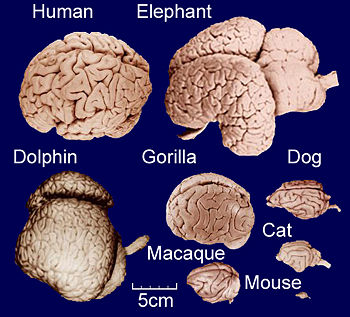Brain size: Difference between revisions
Jump to navigation
Jump to search


imported>Daniel Mietchen |
imported>Daniel Mietchen |
||
| Line 10: | Line 10: | ||
*[[microcephalin]] (MCPH1) and [[ASPM]] (MCH 5) (cf. [[CZ:Ref:Stern 2006 Evolutionary Genetics: is brain evolution still continuing in modern humans?|Stern and Woods, 2006]]; [[CZ:Ref:Tang 2006 Molecular genetic determinants of human brain size|Tang 2006]]) | *[[microcephalin]] (MCPH1) and [[ASPM]] (MCH 5) (cf. [[CZ:Ref:Stern 2006 Evolutionary Genetics: is brain evolution still continuing in modern humans?|Stern and Woods, 2006]]; [[CZ:Ref:Tang 2006 Molecular genetic determinants of human brain size|Tang 2006]]) | ||
*[[pelvis|pelvic]] size in females (cf. [[CZ:Ref:Ridley 1995 Pelvic sexual dimorphism and relative neonatal brain size really are related|Ridley 1995]]) | *[[pelvis|pelvic]] size in females (cf. [[CZ:Ref:Ridley 1995 Pelvic sexual dimorphism and relative neonatal brain size really are related|Ridley 1995]]) | ||
*habitat density (at least in [[bat]]s, cf. [[CZ:Ref:Safi 2005 Bigger is not always better: when brains get smaller|Safi et al., 2005]]) | |||
==Correlates of brain size== | ==Correlates of brain size== | ||
Revision as of 07:20, 29 January 2009
This article uses direct referencing.

(CC) Photo: University of Wisconsin and Michigan State Comparative Mammalian Brain Collections and National Museum of Health and Medicine (see http://www.brainmuseum.org/)
Comparative anatomy of adult brains from various vertebrate species, highlighting the gradual differences in brain size and gyrification.
Comparative anatomy of adult brains from various vertebrate species, highlighting the gradual differences in brain size and gyrification.
Since the brain has enlarged considerably during hominid evolution, brain size is a central term in many discussions related to cognitive evolution, intelligence and a number of brain disorders, especially microcephaly. To compare different brains, several indicators of brain size have been used. These include absolute brain size, relative brain size (normalized by body size or weight), and the encephalization coefficient.
Determinants of brain size
- microcephalin (MCPH1) and ASPM (MCH 5) (cf. Stern and Woods, 2006; Tang 2006)
- pelvic size in females (cf. Ridley 1995)
- habitat density (at least in bats, cf. Safi et al., 2005)
Correlates of brain size
- Gyrification (cf. Hofman 1989 and Casanova et al., 2004),
- maximum rate of population increase (Isler & Van Schaik, 2009)
- basal metabolic rate (Isler & van Schaik, 2006a)
- flight musculature (at least in birds, cf. Isler & van Schaik, 2006b)
- wing area (at least in bats, cf. Safi et al., 2005)